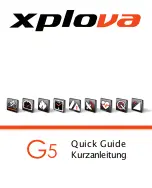
29
brass are used in their natural forms and can withstand the elements with no additional protection required. The
majority of your bicycle however is fabricated from aluminum alloys which have either a painted finish or have been
anodized. Aluminum does not rust but can discolor and corrode over time. The frame has a 3 layer paint finish
which protects the aluminum and graphics. Components such as the handlebars, crank arms, chain guard, seat
post and more have been anodized through an electrolytic process which increases corrosion and wear resistance.
If the frame or components become scratched, these items could slightly corrode around the scratched area.
Depending on the care of your bicycle, a scratch could take years or months for corrosion to appear. To maintain
future value and years of beauty, it is best to be careful when folding and moving your bicycle not to scratch the
metal surfaces. If scratching a surface, use clear nail polish or black nail polish to cover the scratch,
c.
Brake Adjustments
The brakes on your G Plus Genesis 500 are high performance Promax disc brakes. The front and rear brakes are
Promax’s DSK-715 Bearing Caliper brakes with “Tool Free” adjusting knobs. They have powerful stopping power
but must be properly adjusted. Adjusting your brakes will be required from time to time due to either the brake pads
wearing or the brake cables stretching. Both front and rear brake systems are easy to adjust with multiple adjusting
points. Please follow the instructions below on how to adjust your brakes. If you are unsure as to a component or
installation procedure, please contact your local Prodeco Technologies authorized dealer.
CAUTION:
The braking performance may perform less than 100% at first until the pads are broken-in and can
achieve their normal braking performance. After the first few rides, re-tension the brake cable to take up the initial cable
stretch that occurs.
DSK-715 Tool Free Caliper Adjustments
The brake pads will be worn during braking, which means the clearance between the two pads will be
greater and the braking feeling will be worse. The brake cable can also stretch and the cable will need to
be tightened from time to time. (SEE PHOTOS ON NEXT FEW PAGES)
The Promax DSK-715 brakes need to be adjusted properly to offer ultimate stopping power. The
caliper includes a separate outside pad adjusting knob which allows the outside pad to be adjusted
closer to the rotor as it wears. This appears as a red dial behind the caliper that you can adjust without
the use of tools. Simply rotate the red dial clockwise or counterclockwise to tighten or loosen the
adjustments. The inside pad can be adjusted closer to the rotor simply by re-tightening of the cable at
the disc caliper arm and cable lock plate. If on the road for a ride and needing to tightening brakes, this
can be performed via the barrel adjuster bolt at the brake lever and the barrel adjuster bolt at the brake
caliper. When adjusting through the barrel bolts located at the lever assembly or caliper, you should re-
tighten the cable through the caliper arm and lock plate after the ride. You will need to screw the barrel
bolts back into their full in positions prior to adjusting at the caliper arm. The amount of adjustment via
the caliper arm should be limited to less than 1mm. The brake calipers have the ability to slide inward
and outwards by loosening the caliper adapter bolts and sliding the caliper either way. For best
performance, your brakes should be adjusted through the movement of the caliper and the red outside
pad adjusting knob.
Note: The “inside pad” is the pad closest to the brake caliper; the “outside pad” is the pad closest to the
wheel motor or hub and has tool free adjustability.
Your brakes should only be adjusted if stopping power has decreased or your bicycle will not stop
properly. A good way to test your front brake is to get on your bike and with both feet on the ground,
squeeze your front brake lever by applying full pressure. Attempt to push your bike forward while
squeezing the front brake lever only. The front brake should hold the bicycle back and when pushing,
the rear wheel should lift off the ground. If pushing and the bike moves forward including the front
wheel turning, your brake needs to be adjusted or new brake pads are needed. If the bikes slides
forward and the tire does not spin, try this test on a surface with more traction. If your pads need
replacing, section d “Brake pad replacement” of this chapter explains details on replacing brake pads.
To adjust your brakes in a quick and simple manner, follow these guidelines. These guidelines do not replace a
proper adjustment from an authorized dealer but will allow you to increase braking power.
Check the brake lever assembly first and confirm the brake adjusting barrel is completely screwed in.
Check the adjusting bolt at the caliper also and confirming it is threaded fully in.
















































